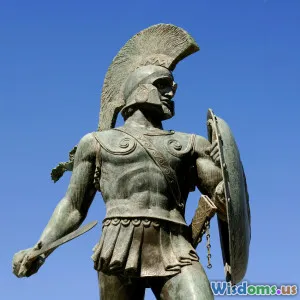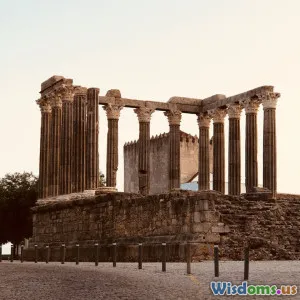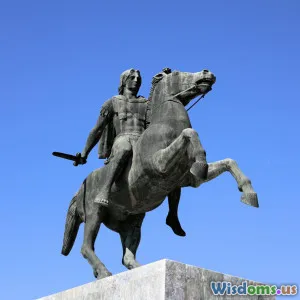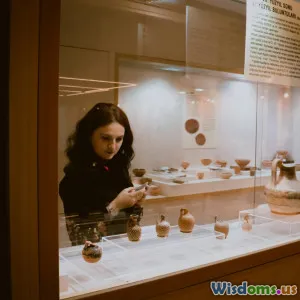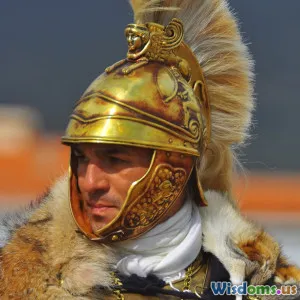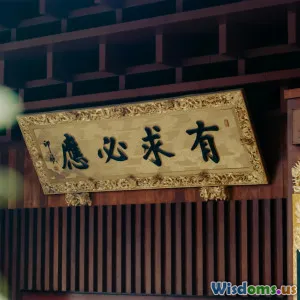
Building Empires Ancient Lessons for Leadership Today
16 min read Discover ancient empire-building strategies and their practical lessons for modern leadership success. (0 Reviews)
Building Empires: Ancient Lessons for Leadership Today
From the towering pyramids of Egypt to the complex roads of Rome, some of history’s most formidable achievements were possible because of visionary leaders whose empires shaped the world. While centuries separate us from Ramses’ Nile or Ashoka’s India, the principles that built and sustained those empires remain astoundingly relevant. Navigating markets, managing digital teams, or starting a business—today’s leaders often face challenges that would feel familiar to Caesar or Cleopatra. Let’s excavate actionable leadership lessons from the ancients and see how they apply in our hyper-connected, ever-evolving world.
Visionary Goals: Thinking Like the Builders of Empires

Behind every sprawling empire was a leader with an audacious vision. For instance, Alexander the Great’s ambition wasn’t merely to rule Macedonia—it was to unite the Greek and Persian worlds. He tailored his approach, respecting local customs, adopting elements of Persian dress, and, crucially, encouraging marriages between his officers and local populations. This wasn’t just conquest; it was intentional culture-building.
Modern Takeaway:
-
Set Transformative Objectives: Whether you’re building a startup or leading a department, think beyond incremental growth. Just as Augustus imagined a Rome that would endure, modern leaders need a north star—a bold yet clear objective. This could mean disrupting an industry, inventing a new category, or redefining organizational values.
-
Embrace Cultural Integration: Like Alexander, effective leaders today promote diversity and respect for different viewpoints. For example, companies like Google thrive by mixing cultures, backgrounds, and expertise, generating a synergy that single-minded teams might miss.
Action Steps:
- Define a BHAG (Big Hairy Audacious Goal) for your team or organization.
- Consider cultural or contextual nuances as you map your strategy, just as ancient emperors adapted to local realities.
Infrastructure: Laying the Foundation for Long-Term Success

Empires are as much about roads, canals, and aqueducts as they are about kings and generals. The marvels of the Roman road network or China’s Great Wall reveal a deeper leadership truth: real progress is rooted in systems and structures.
Historical Example:
- The Roman Emperors invested heavily in public works. Roads connected the vast corners of their realm, allowing for rapid military mobilization, trade, and cultural exchange. Similarly, the aqueducts enabled Rome’s expansion by supplying water to a growing population.
Modern Takeaway:
Leaders must prioritize building—not just buying—lasting structures within their organizations:
- Information Networks: Invest in clear and reliable communication tools. For example, Atlassian’s internal wikis and Slack channels power collaborations across global offices, much as Roman roads facilitated trade and dialogue.
- Process and Protocols: Like engineers drawing blueprints for a bridge, leaders must establish repeatable processes for hiring, performance reviews, and decision-making that outlive individual tenures.
Action Steps:
- Audit internal communication—where are the bottlenecks?
- Document and update recurring team workflows.
- Allocate budget to core foundational projects next quarter instead of cosmetic "quick wins."
Adapting to Change: Flexibility Amid Turbulence

No empire lasted forever, but the longest-surviving ones reinvented themselves in response to internal and external shocks. When the Persian Empire faced the challenge of governing diverse peoples, Cyrus the Great adopted a policy of tolerance, letting local customs and religions flourish under his rule.
Historical Example:
- During the reign of Pharaoh Hatshepsut, Egypt’s economy shifted from military conquest to trade. She led major expeditions to Punt (modern-day Somalia), diversifying revenue and forging valuable alliances.
Modern Takeaway:
- Change Management: Today’s leaders must be prepared for rapid pivots—whether from a global pandemic, regulatory shifts, or new technologies. Netflix began as a DVD rental service before streaming revolutionized its business.
Analysis:
- Signal Recognition: Ancient leaders surrounded themselves with advisors, spies, and early warning systems (like Rome’s border forts) to spot threats and trends. Modern leaders must foster a culture where feedback is rapid and transparent—think of how Spotify forces regular team "retros" to surface issues early.
Action Steps:
- Regularly review external trends and customer feedback.
- Build quick-response teams that can rapidly iterate on unexpected challenges.
- Allocate time each month for scenario planning with your executives.
Inspirational Storytelling: Shaping Identity and Loyalty

The best leaders from Cyrus to Cleopatra knew that humans aren’t inspired by logic alone—they respond to stories. Legends, ceremonies, and public spectacles unified vast, disparate populations.
Historical Example:
- Julius Caesar famously documented his own military exploits in the "Commentarii de Bello Gallico," shaping public perception and cementing his authority.
- The Mauryan Emperor Ashoka carved his edicts onto stone pillars scattered throughout India. These messages fostered a shared imperial identity around non-violence and tolerance after a bloody conquest.
Modern Takeaway:
-
Purpose-Driven Narrative: Leaders today must craft stories that align employees and stakeholders. Patagonia’s focus on environmental activism isn’t just strategy—it’s the narrative heartbeat that makes employees proud to belong and customers eager to evangelize.
-
Consistent Messaging: Like imperial decrees, messaging should be accessible and memorable. IKEA’s leadership keeps core values front and center, from Stockholm to San Francisco.
Action Steps:
- Regularly share origin stories and vision during team meetings.
- Use internal blogs or newsletters to communicate mission-critical updates.
- Embed values and principles into onboarding materials and performance reviews.
Building Loyalty: Empowering People, Not Just Commanding Them

Empire-building demanded not only obedience but genuine loyalty. Leaders discovered—often through hard lessons—that imposing rules without buy-in led to uprisings and rebellions.
Historical Example:
- The Mongol Empire, under Genghis Khan, succeeded where many failed by promoting soldiers on merit rather than birth. Loyalty flourished because every person, regardless of their lineage, could rise through the ranks.
- The Persian Empire allowed subject peoples some degree of self-rule, thus reducing resistance and embedding trust.
Modern Takeaway:
- Meritocracy in Action: Google’s "20 percent time" encouraged innovation at every level—the result: products like Gmail and AdSense, both dreamed up outside regular hierarchies.
- Delegation, Not Micromanagement: Empower teams to own projects. Decentralized decision-making leads to greater commitment—and fosters leadership at every level, much as Roman legions’ centurions made field-level decisions.
Action Steps:
- Audit promotion and review systems to ensure advancement is performance-based.
- Delegate meaningful projects and celebrate individual contributions.
- Implement feedback loops for bottom-up suggestions and act on them.
Navigating Power Struggles and Political Currents

Empire-building was as much about managing alliances, betrayals, and negotiations as anything else. Ancient rulers developed sophisticated diplomatic strategies to outmaneuver rivals and foster stability.
Historical Example:
- The Byzantine Empire thrived for centuries after Rome’s fall by skillful diplomatic maneuvering—bribing, buying time, and playing enemies against one another rather than costly wars.
- Cleopatra VII brokered alliances with Rome’s most powerful men—Julius Caesar and Mark Antony—to secure her throne amidst endless palace intrigue.
Modern Takeaway:
- Organizational Politics: Every organization has "informal" power centers. Effective leaders do not ignore these dynamics; instead, they build alliances, manage conflict calmly, and ensure their vision survives leadership transitions.
- Negotiation Skills: Like ancient diplomats, leaders must seek win-win outcomes, forging partnerships and coalitions internally and externally. Think of Satya Nadella’s shift at Microsoft: by building bridges with competitors like Linux and open source, Microsoft became more relevant and dynamic.
Action Steps:
- Map the key influencers and power brokers in your company.
- Practice active listening and negotiate rather than dictate when handling disputes.
- Create cross-team task forces to break down silos and foster cooperation.
Succession Planning: Preparing for the Next Generation

The downfall of many empires was a failure to plan for succession. From Alexander’s sudden demise ("to the strongest!") sparking wars amongst his generals, to crises from disputed Pharaohs, stability often rested on robust processes for transfer of power.
Historical Example:
- When Augustus became Rome’s first Emperor, he spent years carefully positioning his eventual replacement, ensuring a smooth transfer that avoided chaos.
- China’s Han Dynasty established civil service systems to enable merit-based official appointments, buffering against arbitrary aristocratic succession.
Modern Takeaway:
- Talent Pipelines: Prepare rising stars through mentorship and deliberate development. Companies like GE famously rotate managers between roles and continents, producing adaptable leaders ready for anything.
- Knowledge Management: The loss of institutional knowledge can be as catastrophic as losing territory. Use handover protocols, documentation, and archiving lessons learned.
Action Steps:
- Identify high-potential employees and assign mentors.
- Mandate written project retrospectives and playbooks.
- Discuss succession openly, even (and especially) if it feels uncomfortable.
Resilience in the Face of Crisis: Learning from Collapse

Many empires eventually fell—to invasion, disease, or internal strife. But history’s pages are equally full of stories where leaders turned disaster into opportunity.
Historical Example:
- After Rome was sacked in 410 CE, Aurelian rallied what remained, stemming chaos with decisive leadership, reforms, and clear communication.
- The Ottomans, after defeat at the Battle of Ankara in 1402, survived their “interregnum” by encouraging timar lords to compete for audience and authority until a new royal could unite them.
Modern Takeaway:
- Crisis Management: When COVID-19 upended the workplace, agile organizations didn’t just cut—they communicated honestly, pivoted to remote work, and prioritized wellbeing. Shopify’s founder declared early, “office centricity is over,” giving clarity where others hesitated.
- Mindset for Recovery: Frame setbacks as opportunities for reinvention. Take Blockbuster’s fate—a failure to adapt and rebound—versus Apple, which rebounded via iPod and iPhone after near-bankruptcy under Steve Jobs.
Action Steps:
- Institute regular crisis drills and scenario plans.
- Involve teams in after-action reviews and lessons-learned sessions.
- Publicly celebrate turnarounds, both individual and organizational.
The Legacy of Empire: Ethical Leadership That Endures

Finally, the question for every leader—ancient or modern—is not only what is built, but what endures. Empires are often remembered as much for how they treated their people as for what they conquered.
Historical Example:
- Ashoka is revered not for winning wars but for renouncing violence and advocating "dhamma"—justice, tolerance, and welfare.
- Emperor Marcus Aurelius wrote “Meditations,” emphasizing service, fairness, and duty—a philosophy still foundational for leaders today.
Modern Takeaway:
- Sustainable Leadership: Leaders set standards not just for profits or engineering marvels, but for ethical stewardship. Think of Paul Polman, who overhauled Unilever, making sustainability a core metric, proving that profit and purpose can coexist.
- Meaningful Impact: Like great emperors, modern leaders have the chance to leave behind organizations, and communities, more just and resilient than those they inherited.
Action Steps:
- Embed ethics and accountability into every decision.
- Measure success with both "hard" (revenue, growth) and "soft" (ESG, wellbeing, cultural values) metrics.
- Ask regularly: if this were the only legacy I left, would I be proud?
Every startup team, multinational corporation, or grassroots movement can benefit from the hard-won wisdom of strategists, story-shapers, and change-makers who raised empires from dreams. The pharaohs and generals may be gone, but their leadership playbook remains more alive—and actionable—than ever for those building the future.
Rate the Post
User Reviews
Popular Posts











